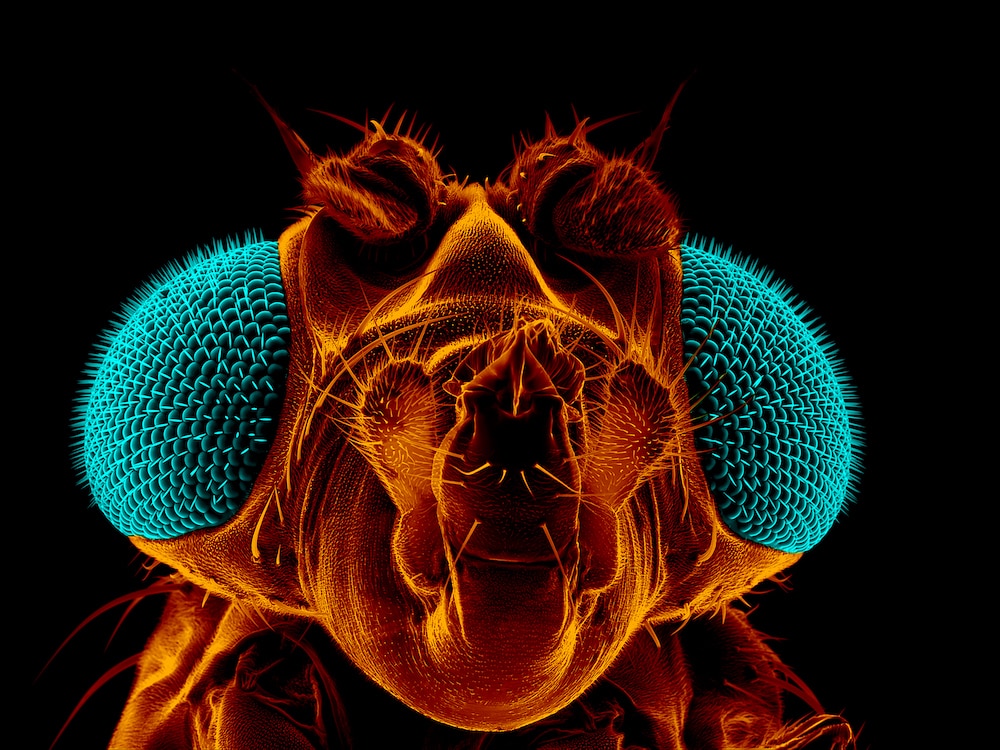Create a free profile to get unlimited access to exclusive videos, sweepstakes, and more!
Heard the buzz? Turns out flies have more brains than we originally thought
This is really buzzworthy.

Unless you’re thinking of Jeff Goldblum’s humanoid-insectoid character in The Fly, you probably don’t think much of fly brains. How much can one of the most-swatted insects ever tell us anyway?
Brundlefly didn’t make an appearance in anyone’s lab (or teleportation machine). What a team of researchers led by Ralph Greenspan of UC San Diego did find out was that flies have cognitive capabilities far beyond what we assumed. When Greenspan built a bug-sized virtual reality arena to convince the flies they were actually flying outside, he found out that they show signs of attention, short-term memory and even some semblance of conscious awareness.
To find the area of the fly’s brain where memories formed and then dissipated, Greenspan, who led a study recently published in Nature, had to highlight a certain gene.
“We did targeted expression of a potassium channel gene that short-circuits the cells so they are silenced,” he told SYFY WIRE.
Turns out that the ellipsoid body in the brain of the humble fruit fly echoes aspects of the mammalian cerebral cortex. This is kind of huge for a creature that only has around 100,000 neurons compared to our 100 billion. Flies use this structure to navigate. The neurons in the ellipsoid body are arranged with their axons, or long tail-like ends, in circles within circles, ready to zap impulses from one neuron to another. This arrangement depends on a protein known as semaphorin, which tells axons what to do. Semaphorins also influence axons in mammal brains.
The cerebral cortex in mammals is obviously much more complex than anything a fly could dream of. It is the outermost layer of the brain that deals with everything from motor function to concentration to sensations, emotions, vision and even smelling, but don’t underestimate flies just yet. Greenspan built a panoramic arena to give the flies a virtual reality experience that was totally immersive. They were tethered, but the VR system would constantly change depending on their wing movement, so they felt as if they were free and buzzing around.
“The fly brain’s relevance to the human brain can be inferred from our knowing the molecular homologies (in gene expression in development and in physiological mechanisms) that have traced the common evolutionary roots of fly and mammalian brains,” Greenspan said.
Flies underwent training that would later help them perform conditioning tasks. They learned that they could back off from an image that was associated with the heat being turned up and move towards one where it was cooler. Then visual stimuli were purposely shown to the insects, either simultaneously with heat, or with heat following seconds after a stimulus was flashed before them. Here is where it starts to get kind of eerie. That time in between, or “trace interval” is when the fly’s brain hangs on to a “trace” of what it just saw. This also occurs in mammals. Remind you of anything, like memory?
Not only were the flies showing that their short-term memory was switched on, but it also became evident that they could get distracted. It only took a slight whoosh of air to throw them off and also make the visual memory get hazy. This is the first time ever that the tendency to get distracted has been proven in flies. So they can remember, pay attention and be aware of what is going on around them. There is obviously a lot happening behind those compound eyes.
“We hope to dig deeper into the molecular mechanisms in the fruit fly brain, including its kinetics, and charting the interactions among all of the brain regions (of which there are more than just the necessary ones we showed),” said Greenspan.
Anyone who ever doubted the cognitive abilities of flies can now buzz off.


























